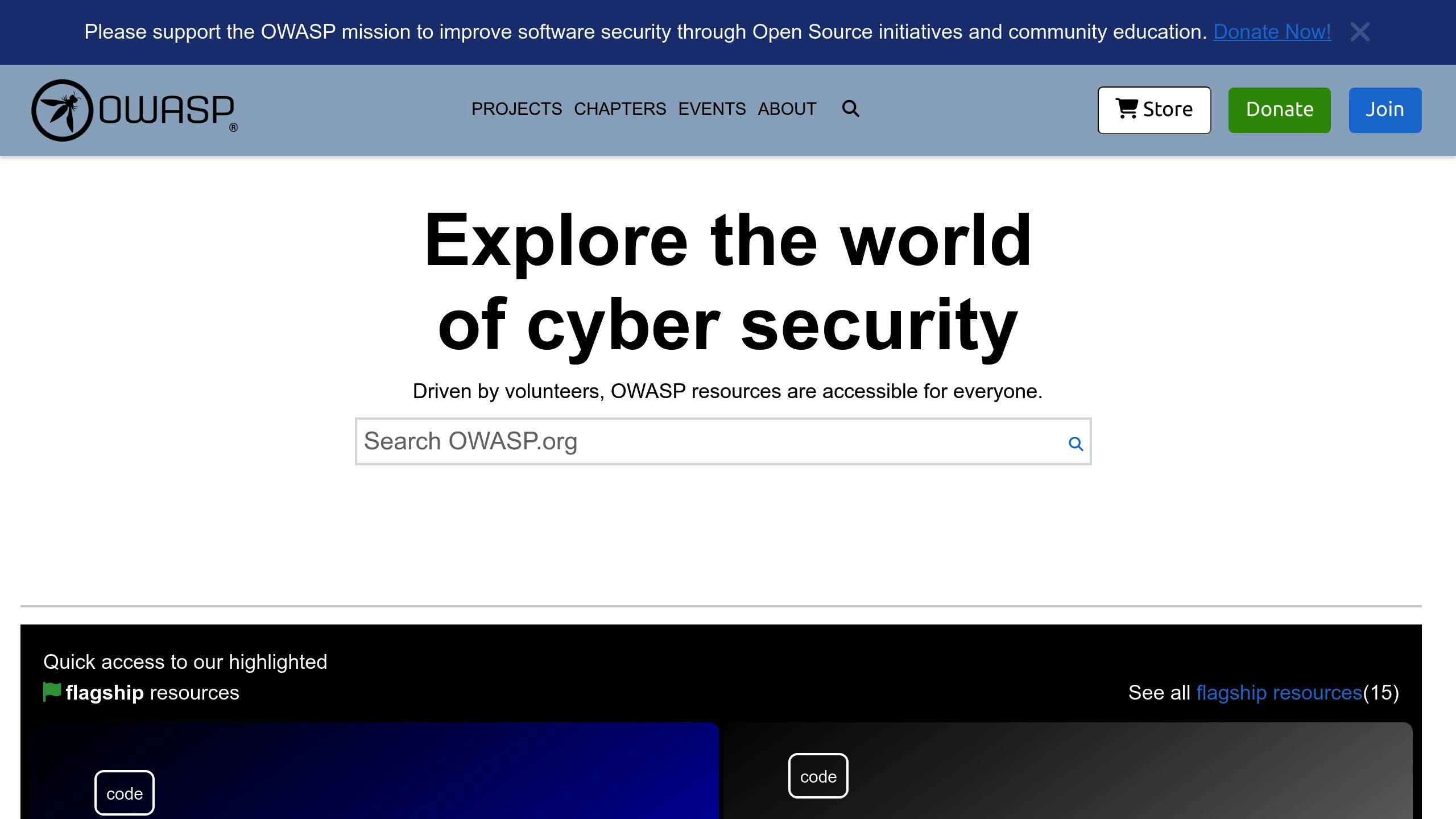61% of web applications are vulnerable to attacks like Cross-Site Scripting (XSS). Web security is critical to protect sensitive data, prevent financial losses, and maintain user trust. This guide covers the OWASP Top 10 vulnerabilities and how to prevent them, including SQL injection, XSS, broken authentication, and more.
Key Takeaways:
- SQL Injection: Use parameterized queries and validate inputs.
- XSS: Apply Content Security Policies (CSP) and sanitize user inputs.
- Broken Authentication: Implement multi-factor authentication and secure session management.
- CSRF: Use anti-CSRF tokens and SameSite cookie attributes.
- Security Misconfigurations: Regularly scan and secure default settings.
Quick Overview of Solutions:
| Vulnerability | Solution |
|---|---|
| SQL Injection | Parameterized queries, input validation |
| XSS | CSP, input sanitization |
| Broken Authentication | MFA, session timeouts |
| IDOR | Role-based access controls |
| Security Misconfiguration | Secure headers, regular audits |
| Sensitive Data Exposure | TLS, encryption, strict access controls |
| CSRF | Anti-CSRF tokens, SameSite cookies |
| Insecure Deserialization | Validate serialized data, integrity checks |
| SSRF | Input validation, network segmentation |
Pro Tip: Integrate security into every development phase, use tools like OWASP ZAP, and train your team regularly to stay ahead of evolving threats.
OWASP Top 10 2021 Explained

10 Common Web Security Risks and How to Avoid Them
Knowing these risks is the first step toward writing safer code. Below, we’ll cover 10 common vulnerabilities and how to address them.
Understanding SQL Injection
SQL injection is a serious threat that consistently ranks high on the OWASP Top 10 Threat List [4]. This happens when attackers insert malicious SQL code into a web application, potentially gaining access to sensitive data or altering it.
Here’s how to guard against SQL injection:
- Use Parameterized Queries: This separates SQL logic from user input, minimizing risk. For example:
PreparedStatement stmt = connection.prepareStatement("SELECT * FROM users WHERE id = ?");
stmt.setString(1, userId);
- Input Validation: Always filter and validate user input to block harmful data.
Preventing Cross-Site Scripting (XSS)
Cross-Site Scripting allows attackers to inject harmful scripts into web pages viewed by others. To prevent this:
- Use Content Security Policies (CSP) to restrict what scripts can execute.
- Encode all user-generated content.
- Use frameworks like React or Angular, which include built-in XSS protections.
Fixing Broken Authentication
Authentication flaws can expose user accounts to attackers. To strengthen authentication:
| Feature | Benefit |
|---|---|
| Multi-factor Authentication | Adds an extra layer of security beyond passwords |
| Secure Session Management | Ensures session timeouts and proper handling |
Avoiding Insecure Direct Object References (IDOR)
IDOR occurs when users can access data they shouldn’t. Prevent this by:
- Using role-based access controls.
- Enforcing object-level authorization checks.
Addressing Security Misconfiguration
Misconfigurations often stem from incomplete or rushed setups. Here’s how to avoid them:
- Remove default credentials and disable unnecessary features.
- Use secure headers like Content-Security-Policy and X-Frame-Options.
- Regularly scan for vulnerabilities.
Protecting Sensitive Data
Safeguard sensitive information by:
- Using TLS for secure data transmission and AES for encryption at rest.
- Setting up strict access controls.
- Conducting regular security reviews.
Enforcing Function-Level Access Control
To ensure users only access what they’re authorized to:
- Implement role-based access control (RBAC).
- Regularly review and audit permissions.
- Follow the principle of least privilege.
Defending Against Cross-Site Request Forgery (CSRF)
CSRF tricks users into performing actions they didn’t intend. Protect your app by:
- Using anti-CSRF tokens.
- Setting SameSite attributes on cookies to limit cross-origin requests.
Securing Against Insecure Deserialization
Insecure deserialization can lead to remote code execution. Prevent this by:
- Validating all serialized data.
- Using safer serialization formats.
- Adding integrity checks to serialized objects.
Preventing Server-Side Request Forgery (SSRF)
SSRF exploits a server’s ability to make requests. Mitigate this by:
- Validating input to block unsafe requests.
- Segmenting your network to limit access.
- Using URL whitelists.
- Proxying external requests for added control.
Ongoing security checks and updates are crucial. Regular audits, software updates, and adopting a secure development lifecycle (SDLC) can help you stay ahead of these risks. Stay proactive to keep your applications safe.
Key Practices for Web Security
Building Security into Development
Incorporating security measures throughout the software development lifecycle (SDLC) is essential for creating secure web applications. Addressing vulnerabilities early ensures they’re tackled at the source, rather than becoming last-minute fixes.
Here’s how security can align with each phase of development:
| Development Phase | Security Actions |
|---|---|
| Early Development | Threat modeling, secure coding guidelines, and peer code reviews |
| Testing | Automated scans and penetration tests |
| Deployment | Validating security configurations |
| Maintenance | Routine audits and timely updates |
Making security a part of the development process from the start is key. And using the right tools can make identifying and fixing vulnerabilities much more effective.
Using Security Tools
Security tools play a major role in identifying and addressing vulnerabilities. For example, SonarQube, a popular static code analysis tool, helps developers catch issues early in the coding process. Integrating automated tools into CI/CD pipelines can also speed up vulnerability detection by 27% compared to manual methods [2].
For web application testing, OWASP ZAP and Burp Suite are widely used. OWASP ZAP is great for spotting common issues and offering detailed remediation steps, while Burp Suite provides advanced features like automated scans and API security testing, making it a go-to for enterprise-level needs [3].
However, tools alone aren’t enough. Staying informed about new threats and techniques is just as important.
Ongoing Learning and Training
While tools and secure development practices are essential, continuous training keeps teams ready for evolving threats. Regularly scheduled training sessions can cover critical areas like:
| Training Type | Frequency | Key Topics |
|---|---|---|
| Security Workshops | Quarterly | Emerging threats and mitigation tactics |
| Code Reviews | Weekly | Secure coding and vulnerability detection |
| Threat Simulations | Monthly | Hands-on practice with attack scenarios and responses |
"SQL injection largely depends on an attacker’s ability to manipulate data inputs and database functions. By restricting these inputs and limiting the type of database procedures that can be performed, organizations can minimize the risk of unauthorized or malicious queries." – Cloudflare [5]
Investing in certifications, attending security conferences, and engaging with organizations like OWASP can further strengthen a team’s expertise. These efforts ensure developers are always equipped to handle the latest security challenges.
sbb-itb-f454395
Examples of Web Security Issues
SQL Injection in E-Commerce Systems
The 2017 Equifax breach is a stark reminder of the dangers posed by SQL injection flaws. Attackers exploited an unpatched vulnerability in Apache Struts, exposing the personal data of 147 million people. This breach led to enormous financial losses, compromised sensitive information, and triggered serious legal repercussions. It highlights the critical need for timely updates and secure coding practices.
While SQL injection targets databases, other threats like XSS (Cross-Site Scripting) focus on exploiting client-side vulnerabilities, as seen in the MySpace case.
XSS in Social Media Platforms
The 2005 MySpace "Samy worm" incident serves as an example of how poor input validation and weak security measures can result in widespread harm. A malicious JavaScript embedded in user profiles spread to over one million users in just 24 hours, earning its place as one of the fastest-spreading viruses of its time.
To counter such threats, modern defenses include:
- Enforcing strict security policies to limit script execution
- Using web application firewalls to detect and block harmful traffic
- Regular monitoring and testing to identify vulnerabilities early
Interestingly, organizations that perform weekly security scans detect 61% more vulnerabilities compared to those scanning monthly [3].
These cases emphasize the need for constant vigilance and proactive security measures, which will be discussed in later sections.
Summary and Final Thoughts
Review of the 10 Security Risks
Tackling web security vulnerabilities demands a multi-layered and vigilant approach. Most breaches can be avoided by implementing proper security controls and following best practices. Here’s a quick look at the key layers of security:
| Security Layer | Implementation Strategy |
|---|---|
| Input Validation | Use parameterized queries to block malicious code |
| Access Control | Apply least-privilege principles |
| Monitoring | Set up continuous security monitoring |
| Infrastructure | Use Web Application Firewalls (WAFs) |
Prioritizing Security During Development
Integrating security throughout the development process is essential. This means taking proactive measures, running regular security scans to catch vulnerabilities early, and staying updated on the latest threats and defenses. Building a culture of continuous learning within your team helps keep everyone prepared for evolving risks.
Resources to Deepen Your Knowledge
For those looking to expand their understanding, OWASP Documentation provides detailed guides on web security practices. Platforms like KodNest offer training focused on secure development techniques. Additionally, engaging with professional forums and security-focused communities can connect you with experts and provide valuable insights.
Effective web security is all about vigilance. Regular audits, combined with ongoing monitoring and updates, are the backbone of a strong defense. It’s not a set-it-and-forget-it task – staying ahead of new threats requires consistent effort and attention.
FAQs
Which project lists the top 10 web application vulnerabilities?
The OWASP Top 10 is a widely respected guide for identifying and addressing major web security risks. It provides actionable advice for developers and is regularly updated to help organizations focus on key security concerns and prepare for new threats [1][3].
What are three mitigation methods for preventing SQL injection exploits?
SQL injection is a common and dangerous web security issue. Here are three effective ways to prevent it:
- Use Parameterized Queries and Validate Inputs: Keep SQL commands separate from user data, and ensure all inputs meet strict validation rules. This protects against harmful code execution [2][4].
- Restrict Database Access: Follow the principle of least privilege by limiting what database accounts can do and enforcing strong access controls [2][4].
- Leverage Stored Procedures: Use pre-defined SQL queries with proper error handling to reduce the chance of sensitive information being exposed [2][4].
Combining these methods with regular security checks and monitoring strengthens your application’s defenses.





